1993 CADILLAC FLEETWOOD flat tire
[x] Cancel search: flat tirePage 13 of 386
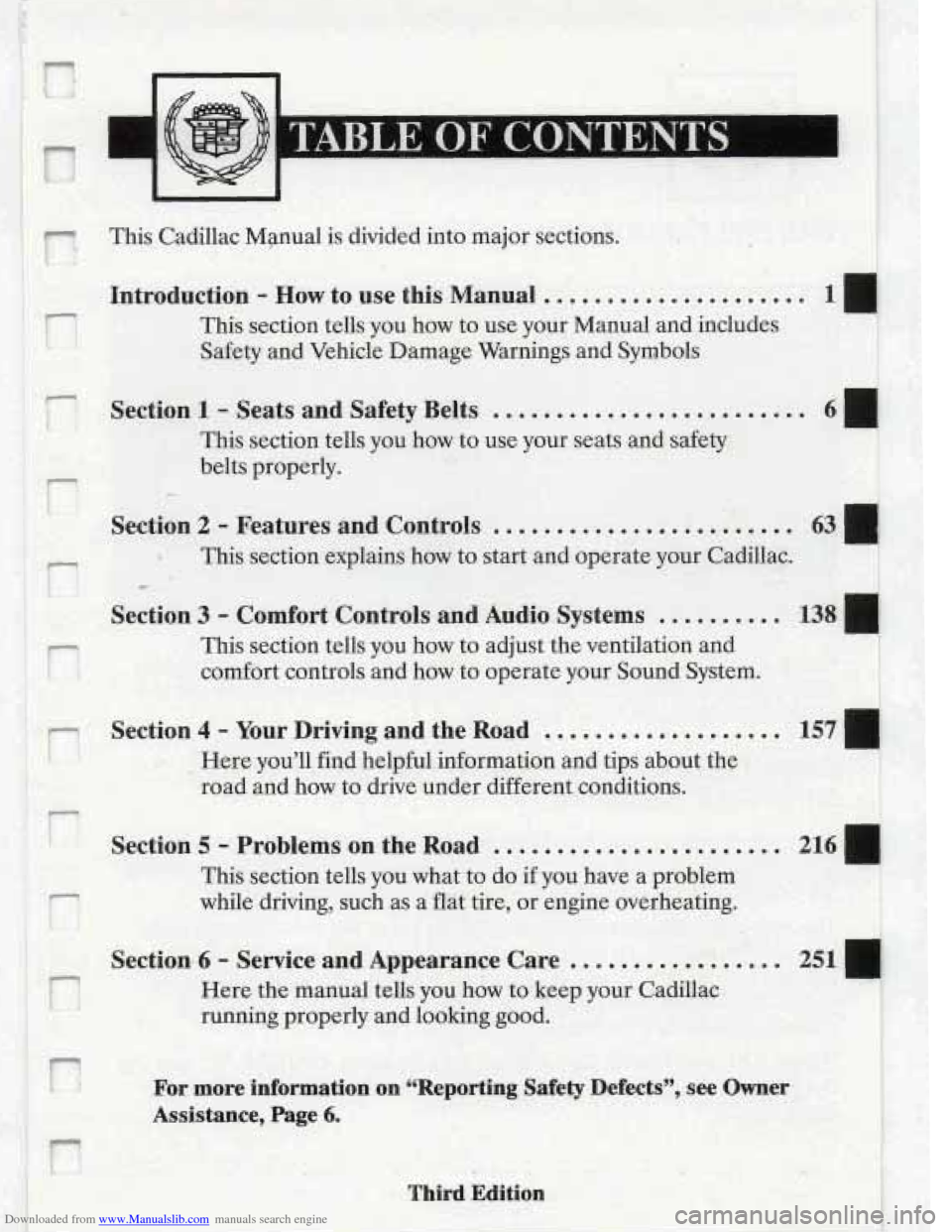
Downloaded from www.Manualslib.com manuals search engine r.
r !
r
This Cadillac Mpnual is divided into major sections.
Introduction - How to use this M,anual. .......... ..........
This section tells you how to use your Manual and includes
Safety and Vehicle Damage Warnings and Symbols I ~
Section 1 - Seats and Safety Belts .........................
This section tells you how to use your seats and safety
belts properly.
.--
Section 2 - Features and Controls .................. .A .... 63 :q
Section 3 - Comfort Controls and Audio Systems .......... 138.4
3 This section explains how to start and operate your Cadillac.
c
This section tells you how to adjust the ventilation and
comfort controls and how to operate your Sound System.
section 4 - Your Driving and the Road ................... 157
,. . Here you’ll. find helpful information and tips about the: ..
road and how to drive under different conditions.
Section 5 - Problems on the Road ....................... 216 4
This section tells you what to do if you have a problem
while driving, such as a flat tire, or engine overheating. ,
I
Section16 - Service and Appearance Care .................
Here the manual tells you how to keep your Cadillac !
running properly and looking good.
For more information on CCReporting Safety Defects”, .see Owner
Assistance, Page 6.
Page 211 of 386
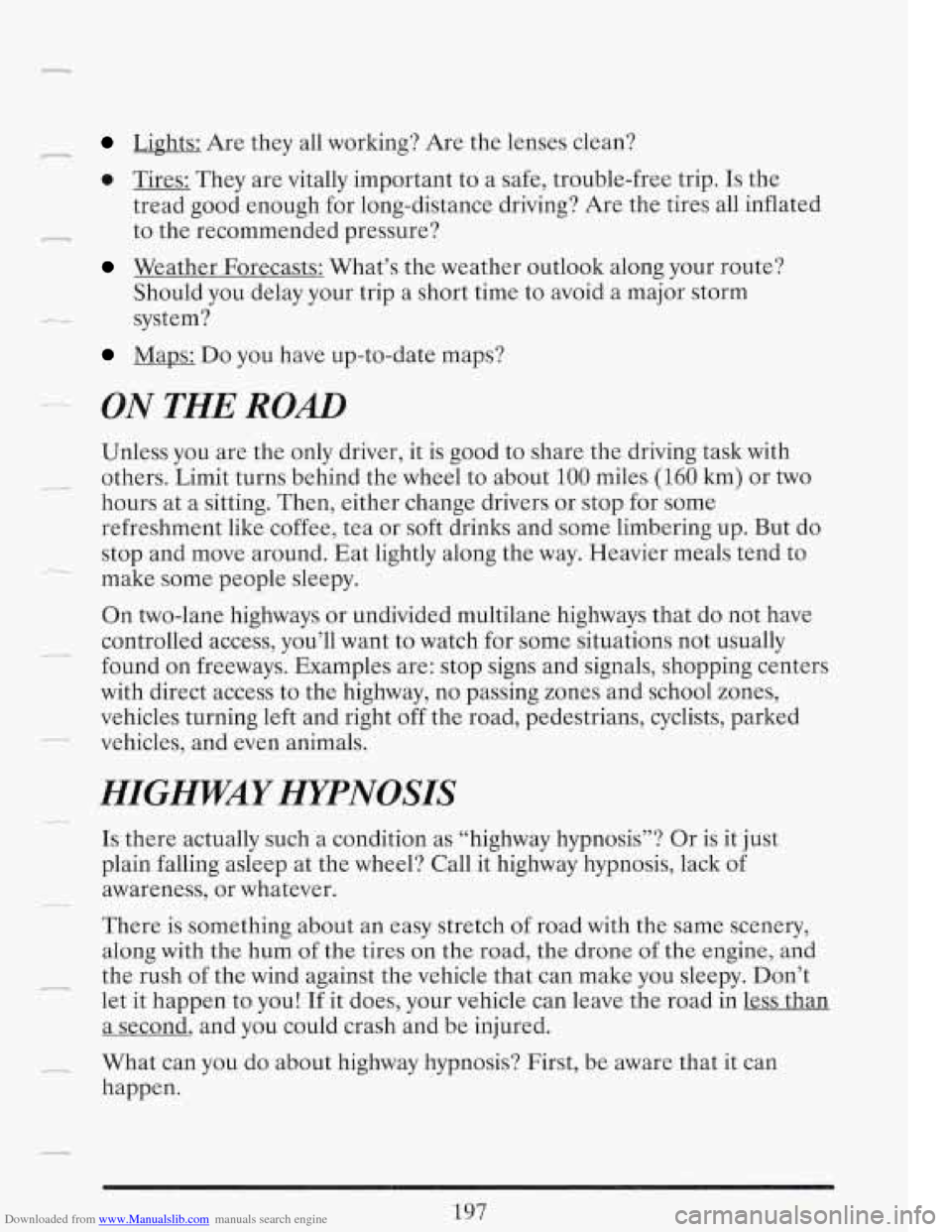
Downloaded from www.Manualslib.com manuals search engine - Lights: Are they all working? Are the lenses clean?
0 Tires: They are vitally important to a safe, trouble-free trip. Is the
tread good enough for long-distance driving? Are the tires all inflated
to the recommended pressure?
Weather Forecasts: What’s the weather outlook along your route?
Should you delay your trip a short time to avoid a major storm
system?
Maps: Do you have up-to-date maps?
_- - ON THE ROAD
Unless you are the only driver, it is good to share the driving task with
hours at a sitting. Then, either change drivers or stop for some
refreshment like coffee, tea or soft drinks and some limbering up. But do
stop and move around. Eat lightly along the way. Heavier meals tend
to
make some people sleepy.
- others. Limit turns behind the wheel to about 100 miles (160 km) or two
- ._
On two-lane highways or undivided multilane highways that do not have
controlled access, you’ll want to watch for some situations not usually
found on freeways. Examples are: stop signs and signals, shopping centers
with direct access to the highway,
no passing zones and school zones,
vehicles turning left and right off the road, pedestrians, cyclists, parked
vehicles, and even animals.
-
-
HIGWAY HYPNOSIS
c_
Is there actually such a condition as “highway hypnosis”? Or is it just
plain falling asleep at the wheel? Call it highway hypnosis, lack
of
awareness, or whatever.
There is something about an easy stretch of road with the same scenery,
along with the hum
of the tires on the road, the drone of the engine, and
- the rush of the wind against the vehicle that can make you sleepy. Don’t
let it happen
to you! If it does, your vehicle can leave the road in less than
a second, and you could crash and be injured.
happen.
__
- What can you do about highway hypnosis? First, be aware that it can
Page 225 of 386
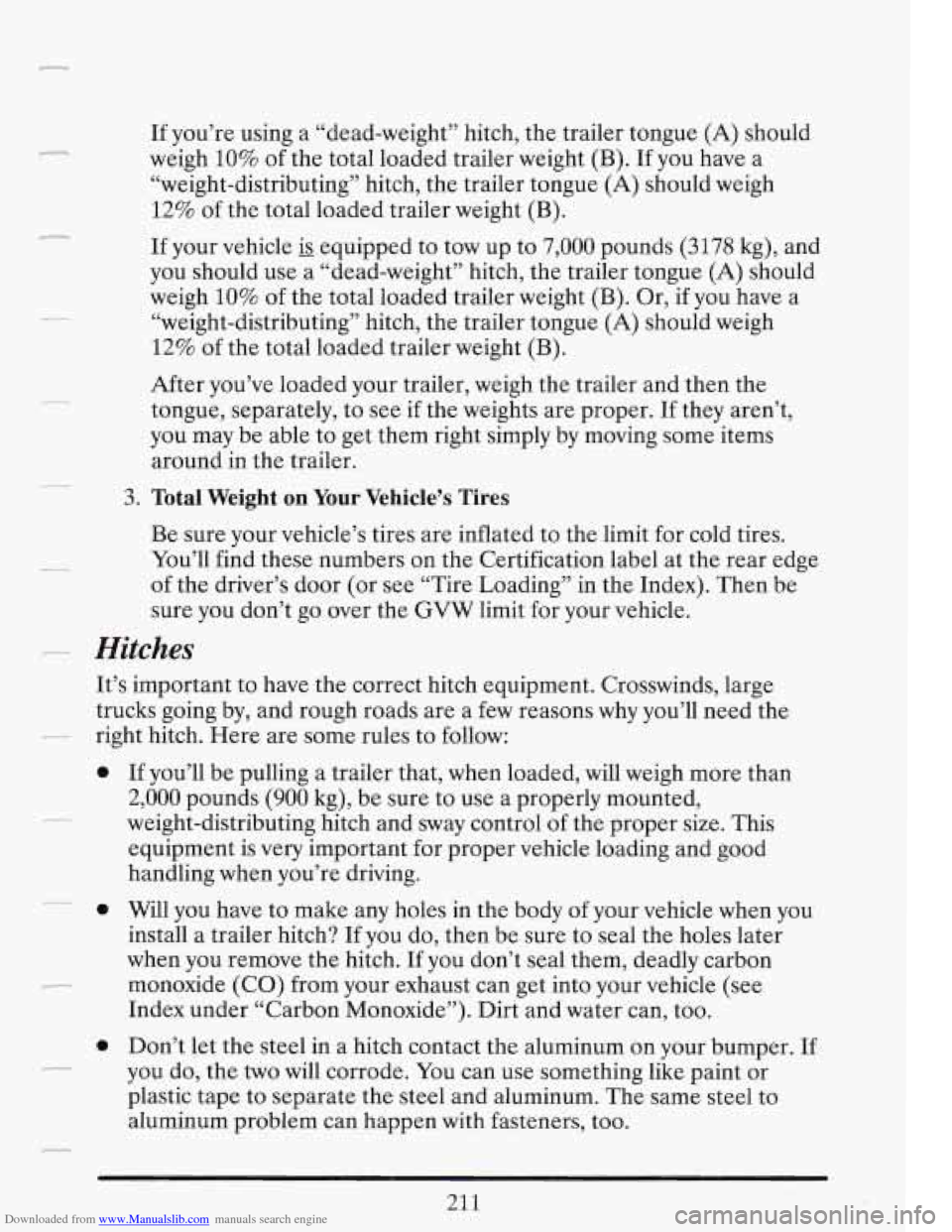
Downloaded from www.Manualslib.com manuals search engine r
r
c-
If you’re using a “dead-weight” hitch, the trailer tongue (A) should
weigh
10% of the total loaded trailer weight (B). If you have a
“weight-distributing” hitch, the trailer tongue
(A) should weigh
12% of the total loaded trailer weight (B).
If your vehicle
is equipped to tow up to 7,000 pounds (3178 kg), and
you should use a “dead-weight” hitch, the trailer tongue
(A) should
weigh
10% of the total loaded trailer weight (B). Or, if you have a
“weight-distributing” hitch, the trailer tongue
(A) should weigh
12% of the total loaded trailer weight (B).
After you’ve loaded your trailer, weigh the trailer and then the
tongue, separately, to see
if the weights are proper. If they aren’t,
you may be able to get them right simply by moving some items
around in the trailer.
3. Total Weight on Your Vehicle’s Tires
Be sure your vehicle’s tires are inflated to the limit for cold tires.
You’ll find these numbers on the Certification label at the rear edge
of the driver’s door (or see “Tire Loading” in the Index). Then be
sure you don’t go over the
GVW limit for your vehicle.
- Hitches
It’s important to have the correct hitch equipment. Crosswinds, large
trucks going by, and rough roads are a
few reasons why you’ll need the
- right hitch. Here are some rules to follow:
0
0
r
If you’ll be pulling a trailer that, when loaded, will weigh more than
2,000 pounds (900 kg), be sure to use a properly mounted,
weight-distributing hitch and sway control of the proper size. This
equipment is
very important for proper vehicle loading and good
handling when you’re driving.
Will you have to make any holes
in the body of your vehicle when you
install a trailer hitch? If you do, then be sure to seal the holes later
when you remove the hitch. If you don’t seal them, deadly carbon
monoxide (CO) from your exhaust can get into your vehicle (see
Index under “Carbon Monoxide”). Dirt and water can, too.
Don’t let the steel in a hitch contact the aluminum on your bumper. If
you do, the
two will corrode. You can use something like paint or
plastic tape to separate the steel and aluminum. The same steel to
aluminum problem can happen with fasteners,
too.
21 1
Page 251 of 386

Downloaded from www.Manualslib.com manuals search engine 8. Then replace the
pressure cap. Be
sure the arrows on
the pressure cap
line up like this.
IF A TIRE GOES FLAT
-- It’s unusual for a tire to “blow out” while you’re driving, especially if you
maintain your tires properly. If air goes out of a tire, it’s much more likely
to leak out slowly. But
if you should ever have a “blowout,” here are a
If a front tire fails, the flat tire will create a drag that pulls the vehicle
toward that side. Take your foot
off the accelerator pedal and grip the
to a stop well out of the traffic lane.
A rear blowout, particularly on a curve, acts much like a skid and may
remove your foot from the accelerator pedal. Get the vehicle under
control by steering the way you want the vehicle to go. It may be
very
the road if possible.
__ few tips about what to expect and what to do:
__ steering wheel firmly. Steer to maintain lane position, then gently brake
__ require the same correction you’d use in a skid. In any rear blowout,
__ bumpy and noisy, but you can still steer. Gently brake to a stop, well off
If your tire goes flat, the next section shows how to use your jacking
--- equipment to change a flat tire safely.
CHMGING A FLAT TIRE
._- If a tire goes flat, avoid further tire and wheel damage by driving slowly to
a
level place. Turn on your hazard warning flashers.
237
Page 254 of 386
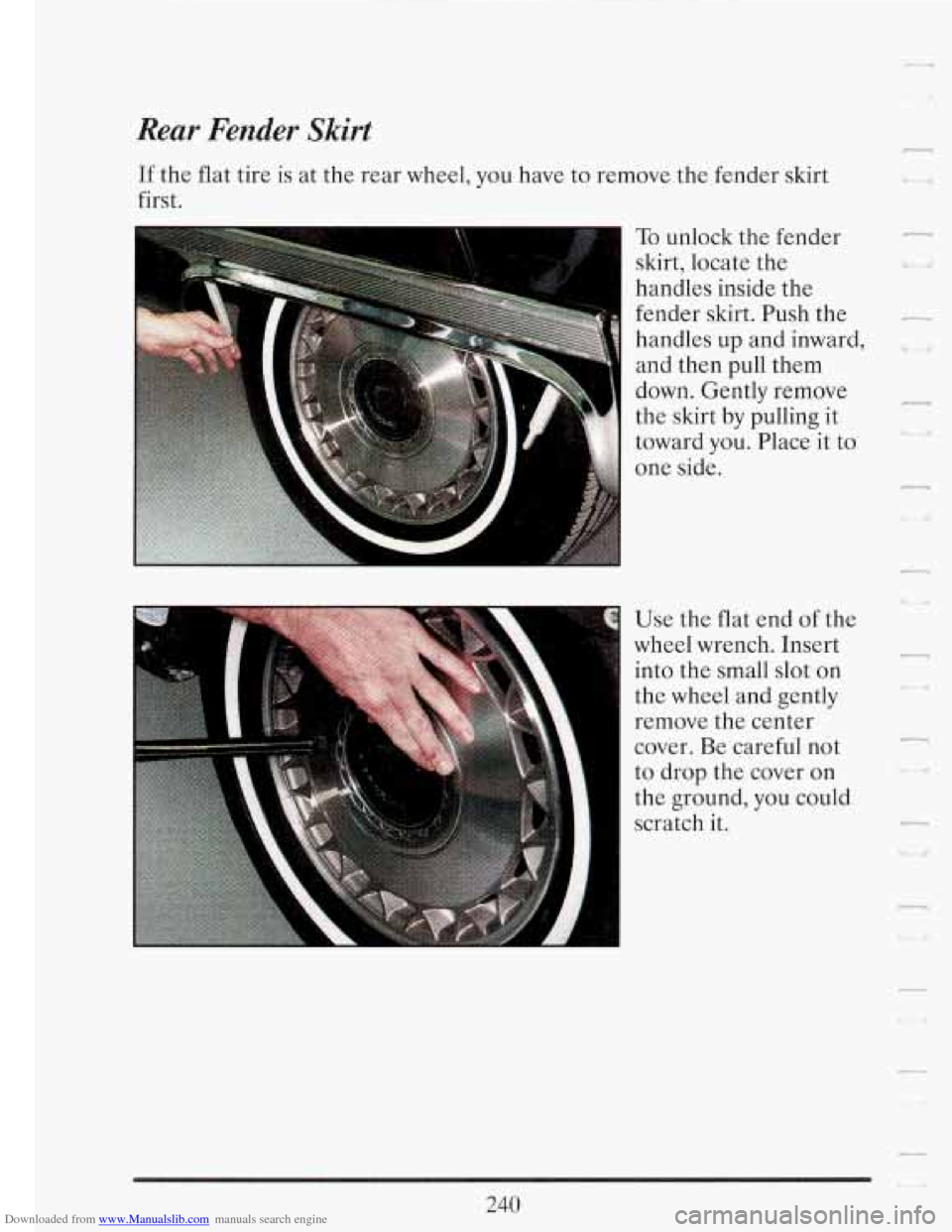
Downloaded from www.Manualslib.com manuals search engine Rear Fender Skirt
If the flat tire is at the rear wheel, you have to remove the fender skirt
first.
n To unlock the fender
skirt, locate
the
handles inside the
fender skirt. Push the
-
handles up and inward, ~
and then pull them
down. Gently remove
IC--
the skirt by pulling it
toward you. Place it to
one side.
3
U
r
Use the flat end of the
wheel wrench. Insert
into the small slot on
the wheel and gently
remove the center
cover. Be careful not
to drop the cover on
the ground, you could
scratch it.
_I
240
Page 255 of 386
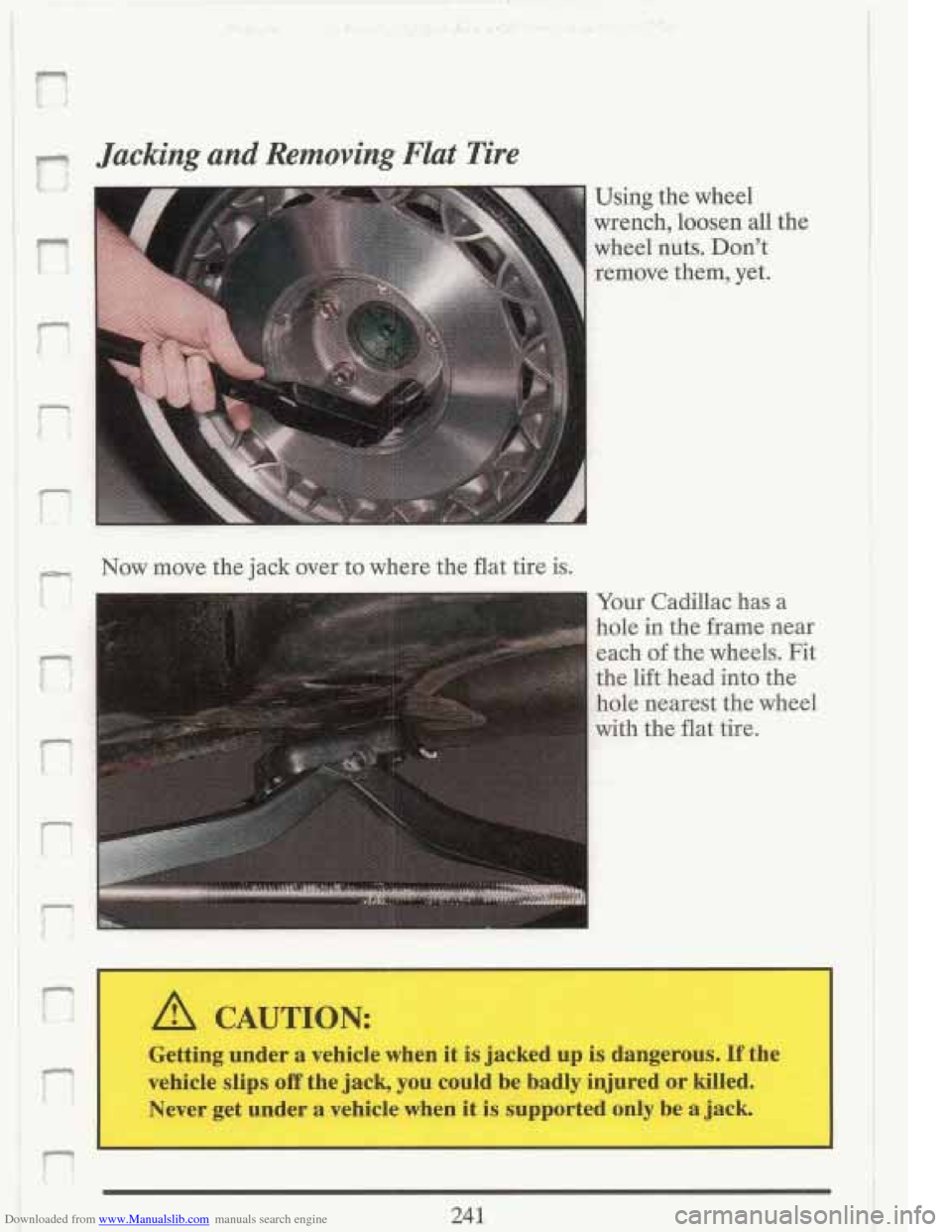
Downloaded from www.Manualslib.com manuals search engine Flat Tire
Using the wheel
wrench, loosen all the
wheel nuts.
Don’t
;emove them, yet.
Your Cadillac has a
hole
in the frame near
each of the wheels. Fit
the lift head into the
hole nearest the wheel
with the flat tire,
A CAUTION:
Getting under a vehicle when it is jacked up is dangerous. If the
vehicle slips
off the jack, you could be badly injured or killed.
Never get under
a vehicle when it is supported only be a jack.
Page 256 of 386
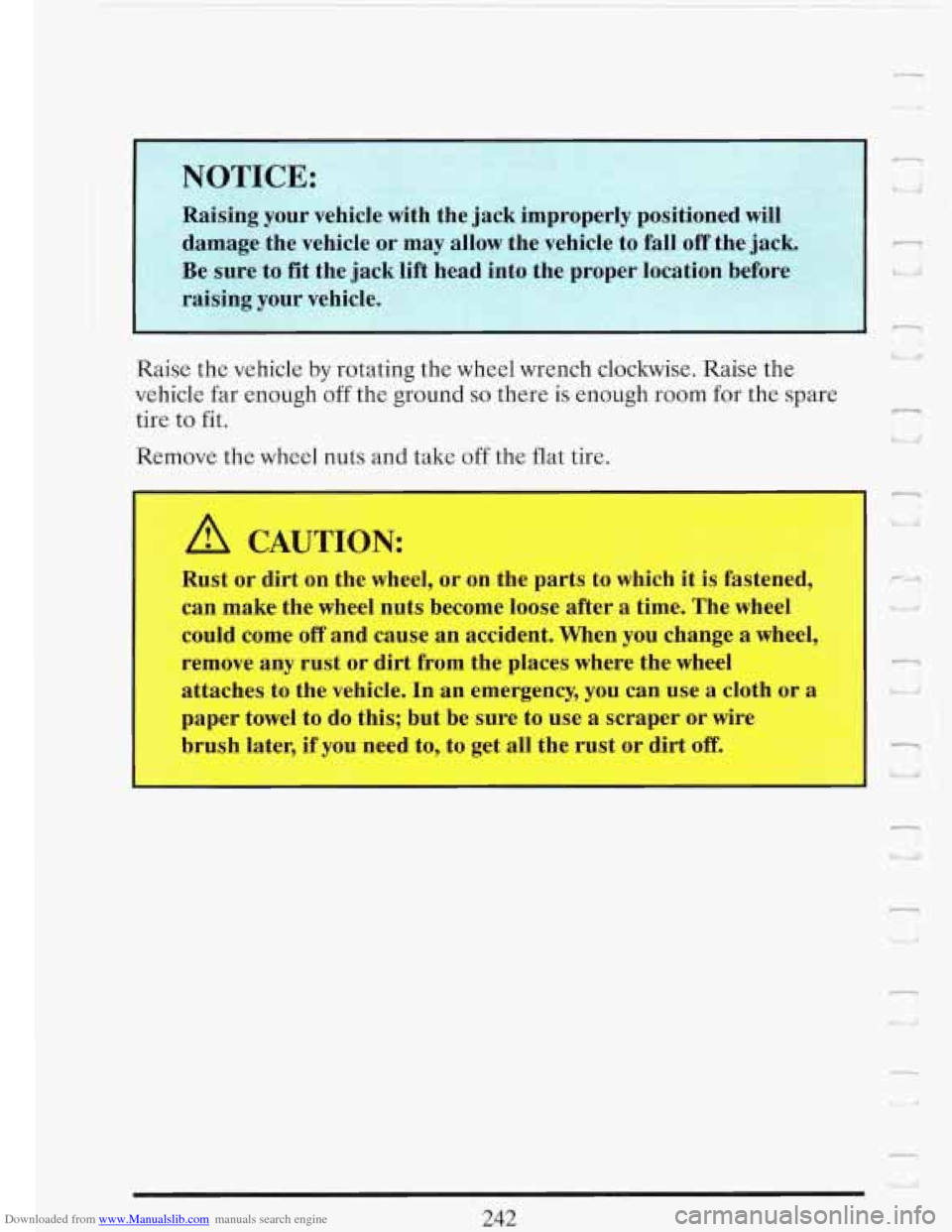
Downloaded from www.Manualslib.com manuals search engine Raise the vehicle by rotating the wheel wrench clockwise. Raise the
vehicle far enough off the ground so there is enough room for the spare
tire to fit.
Remove the wheel nuts and take off the flat tire.
- -
A CAUTION:
Rust or dirt on the wheel, or on the parts to which it is fastened,
can make the wheel nuts become loose after
a time. The wheel
could come
off and cause an accident. When you change a wheel,
remove any rust or dirt from the places where the wheel
attaches to the vehicle. In an emergency, you can use
a cloth or a
paper towel to do this; but be sure to use a scraper or wire
brush later, if you need to, to get all the rust or dirt
off.
U
I
n I " ,
-1
Page 259 of 386
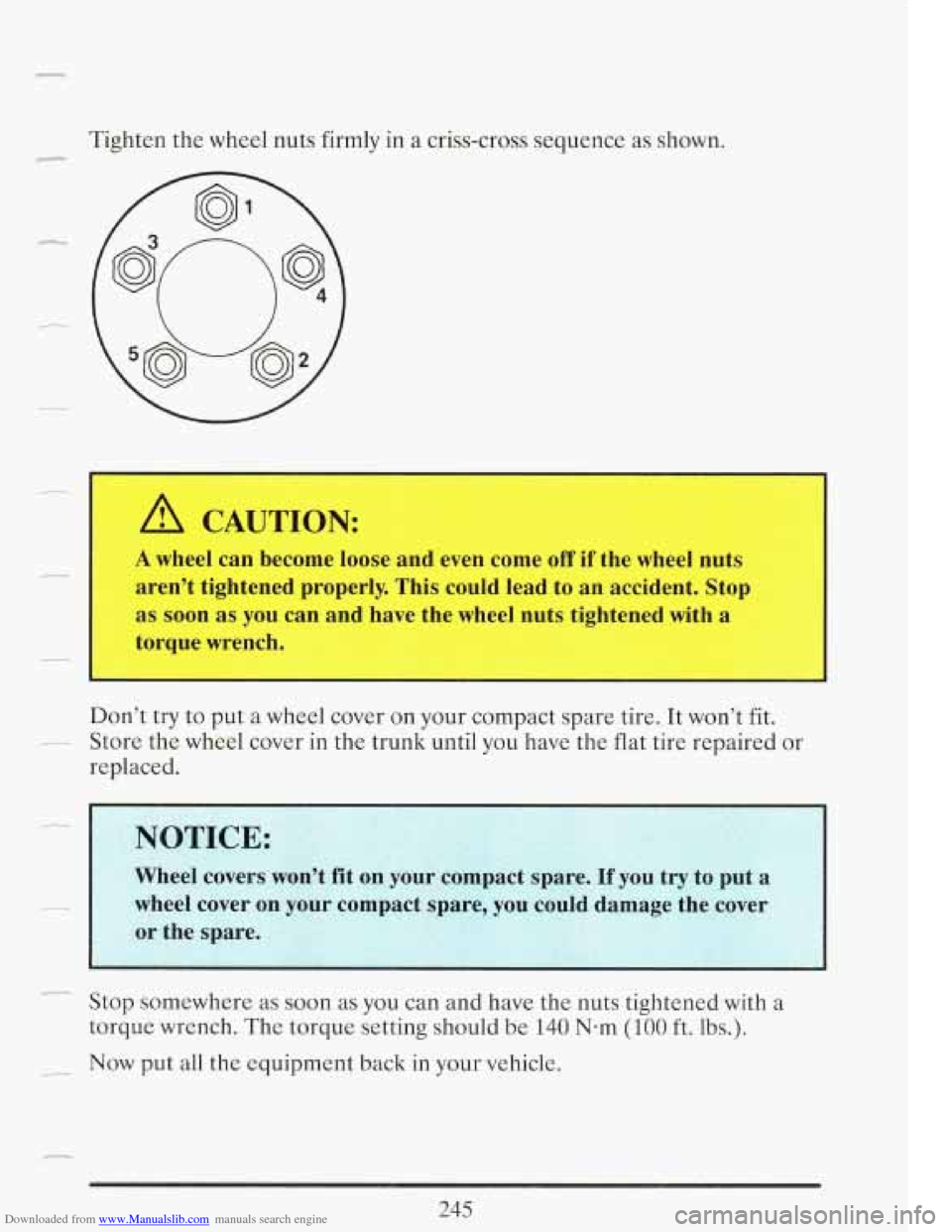
Downloaded from www.Manualslib.com manuals search engine r
Tighten the wheel nuts firmly in a criss-cross sequence as shown.
A CAUTION:
A wheel can become loose and even come off if the wheel nuts
aren’t tightened properly. This could lead to an accident. Stop
as soon as you can and have the wheel nuts tightened with a
torque wrench.
Don’t try to put a wheel cover on your compact spare tire. It won’t fit.
replaced.
- Store the wheel cover in the trunk until you have the flat tire repaired or
r
245